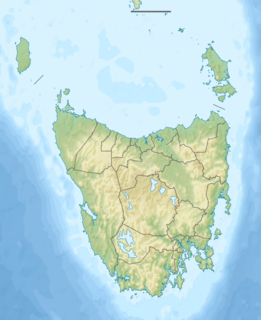| Mount Pelion East | |
|---|---|
 Mount Pelion East | |
| Highest point | |
| Elevation | 1,461 m (4,793 ft) [1] [2] |
| Prominence | 335 m (1,099 ft) [2] |
| Isolation | 3.23 km (2.01 mi) [2] |
| Parent peak | Mount Ossa |
| Listing | 25th highest mountain in Tasmania |
| Coordinates | 41°51′00″S146°03′36″E / 41.85000°S 146.06000°E Coordinates: 41°51′00″S146°03′36″E / 41.85000°S 146.06000°E [3] |
| Geography | |
Location in Tasmania | |
| Location | Central Highlands, Tasmania, Australia |
| Parent range | Pelion |
| Topo map | Tasmap Cathedral 1:25000 |
| Geology | |
| Age of rock | Jurassic |
| Mountain type | Dolerite |
| Climbing | |
| Easiest route | Walk / hike via the Overland Track from Pelion Gap |
Mount Pelion East is a mountain located in the Central Highlands region of Tasmania, Australia. The mountain is situated within the Cradle Mountain-Lake St Clair National Park.

A mountain is a large landform that rises above the surrounding land in a limited area, usually in the form of a peak. A mountain is generally steeper than a hill. Mountains are formed through tectonic forces or volcanism. These forces can locally raise the surface of the earth. Mountains erode slowly through the action of rivers, weather conditions, and glaciers. A few mountains are isolated summits, but most occur in huge mountain ranges.
The Central Highlands is a region in Tasmania, Australia where geographical and administrative boundaries closely coincide. It is also known as The Lake Country of Tasmania.

Tasmania is an island state of Australia. It is located 240 km (150 mi) to the south of the Australian mainland, separated by Bass Strait. The state encompasses the main island of Tasmania, the 26th-largest island in the world, and the surrounding 334 islands. The state has a population of around 533,308 as of March 2019. Just over forty percent of the population resides in the Greater Hobart precinct, which forms the metropolitan area of the state capital and largest city, Hobart.
Contents
With an elevation of 1,461 metres (4,793 ft) above sea level, the mountain is the 25th highest mountain in Tasmania, slightly higher than the better known Frenchmans Cap at 1,446 metres (4,744 ft). Unlike Mount Pelion West, Pelion East is not a massive mountain, more pinnacle-like, the spire shape having been caused by harsh glacial erosion many thousands of years ago.
The Australian Height Datum is a vertical datum in Australia. According to Geoscience Australia, "In 1971 the mean sea level for 1966-1968 was assigned the value of 0.000m on the Australian Height Datum at thirty tide gauges around the coast of the Australian continent. The resulting datum surface, with minor modifications in two metropolitan areas, has been termed the Australian Height Datum (AHD) and was adopted by the National Mapping Council as the datum to which all vertical control for mapping is to be referred."

The Frenchmans Cap is a mountain in the West Coast region of Tasmania, Australia. The mountain is situated in the Franklin-Gordon Wild Rivers National Park.

Mount Pelion West is a mountain located in the Central Highlands region of Tasmania, Australia. The mountain is part of the Pelion Range and is situated within the Cradle Mountain-Lake St Clair National Park at the eastern most boundary of the Murchison River catchment.





















